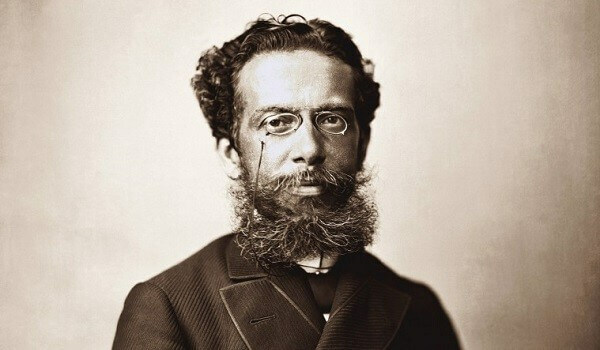“The Posthumous Memoirs of Bras Cubas”, published in 1881, is one of the main works of the writer Machado de Assis. The publication of this novel is considered the starting point of the Realism in Brazil, and its author, consequently, is recognized as the father of such a movement in Brazilian lands.
Summary
- Published in 1881, it inaugurated Realism in Brazil.
- It is a narrative made in the first person, with the unusual fact that the narrator has already died when he started writing.
- The protagonist's childhood is briefly narrated.
- The various loves of Brás Cubas, protagonist of the story, are told.
- The adult life of Cubas, its various attempts at work and invention (such as the plaster) are described.
- Finally, the narrator describes his life as a set of negatives that end with a single positive balance: "I had no children, I did not transmit to any creature the legacy of our misery."
Also access: Eça de Queiroz — an important name in Portuguese Realism
Do not stop now... There's more after the advertising ;)
Context
The historical context that dialogues with the novel The Posthumous Memoirs of Bras Cubas is that of a Brazil buildingyoururbanity, mainly in the city of Rio de Janeiro, the national capital at the time. In general, the work of Machado de Assis portrays the common types and scenes of this Rio society.
The freeing of slaves, in 1888, and its effects on urban life, as well as the Brazilian political restructuring from the Proclamation of the Republic, in 1889, are some of the historical facts that permeate the Machadian book. See, below, an excerpt from the novel in which the narrator portrays his relationship with slaves in childhood:
From the age of five I had deserved the nickname “devil boy”; and truly it was nothing else; I was the most evil of my time, shrewd, indiscreet, mischievous and willful. For example, one day I broke a slave's head because she had denied me a spoonful of the coconut candy I was making, and not happy with the evil, I poured a handful of ash into the pot, and, not satisfied with the mischief, I went to tell my mother that the slave had spoiled the candy “for prank”; and I was only six years old. Prudencio, a boy from home, was my everyday horse; I put my hands on the ground, received a string on my chins, as a bridle, I climbed on his back, with a wand in my hand, lashed him, gave a thousand turns to one and the other side, and he obeyed—sometimes moaning—but he obeyed without saying a word, or, at the most, a—"Oh, honhô!" — to which I retorted: — “Shut up, beast!"
The Posthumous Memoirs of Bras Cubas,
Machado de Assis
To learn more about Machado de Assis, as well as the particularities of his work, read: Machado de Assis: trajectory, characteristics and works.
Analysis of the work
The romance The Posthumous Memoirs of Bras Cubas is constructionscomplex, and the various details present in its plot can only be apprehended after reading, in full, Machado de Assis' book. However, below we describe some of the fundamental points for understanding the narrative.

Machado de Assis is one of the biggest names in Brazilian Literature.
Machado's novel is narrated in firstpeople, having, therefore, a narrator in the first person and, in this structure, there are two fundamental questions:
- First, this choice distances the work from European realist narratives – there the omniscient narrator was used to transfer a greater degree of objectivity to the work;
- Secondly, in addition to the use of a character narrating his life from a particular – and therefore subjective – viewpoint, Brás Cubas, before starting to tell his story, dies. In this sense, the character calls himself not a deceased author, but a deceased author – given that death occurs before the writing of his posthumous memoirs.
Childhood
Brás Cubas' childhood is briefly told in the first chapters of the novel. There, we see the representation of a non-idealized childhood and, in many cases, even cruel – as can be seen in the description of the relationship between the narrator and a slave, transcribed above.
Done in this way, the portrait of children's years push away the novel by Machado de Assis from Romanticism, a movement in which youth is seen as an ideal and cause for longing.
Loves
O love is another element that drives the romance away The Posthumous Memoirs of Bras Cubas of aesthetics romantic – movement that was succeeded by Realism.
For romantics such as José de Alencar and Álvares de Azevedo, the feeling of love was represented as the greatest goal of life and, in many cases, unattainable. Furthermore, the figure of the beloved was idealized and unique.
In Machado de Assis' novel, however, there is no idealization of love or the woman. In fact, Brás Cubas has a great passion in life, the character Virgília. However, it is neither unique nor completely reciprocated and eternal. Other loves of the protagonist are Marcela, Eugênia and Nhã-Loló.
See an excerpt from the novel in which Brás Cubas describes his greatest love, Virgília:
Virgília? But then she was the same lady as a few years later... The same; she was just the lady, who in 1869 was to witness my last days, and who before, long before, had a large part in my most intimate sensations. At that time she was only about fifteen or sixteen; she was perhaps the boldest creature of our race, and certainly the most willful. I don't say that he would have the primacy of beauty, among the young ladies of the time, because this is not a novel, in which the author gilds reality and closes his eyes to freckles and pimples; but I don't say that any freckles or pimples marred his face either. She was beautiful, fresh, came out of the hands of nature, full of that spell, precarious and eternal, which the individual passes to another individual, for the secret purposes of creation. That was Virgília, and she was fair, very fair, cheeky, ignorant, childlike, full of mysterious impulses; a lot of laziness and some devotion — devotion, or perhaps fear; I believe fear.
The Posthumous Memoirs of Bras Cubas,
Machado de Assis
Brás Cubas Plaster
At the end of his life, Brás Cubas assumes the responsibility of creating a medicine capable of curing all the diseases in the world. Such a project, obviously, doesn't work out and becomes another of the narrator's frustrations. Read below the moment when the narrator tells of the idea of the remedy, entitled “Emplasto Brás Cubas”:
In fact, one morning, as I was walking around the farm, an idea hung in the trapeze that I had in my brain. Once hung up, she went in, flailing, kicking, doing the most daring volatim flips that it is possible to believe. I let myself be contemplating her. Suddenly he took a great leap, stretched out his arms and legs, until he took the shape of an X: decipher me or I'll devour you.
This idea was nothing less than the invention of a sublime medicine, an anti-hypochondriac plaster, designed to alleviate our melancholy humanity.
The Posthumous Memoirs of Bras Cubas,
Machado de Assis
The chapter of the denials
The last chapter of the novel became famous for summarizing the irony it's the pessimism typical of Machado de Assis' writing. In it, Brás Cubas makes a kind of pondering about his own life, which, according to him, can be summarized as a succession of negatives. However, a positive balance ends up remaining for the narrator, as follows:
This last chapter is all negative. I didn't reach the celebrity of the plaster, I wasn't a minister, I wasn't caliph, I didn't know about marriage. The truth is that, along with these faults, I had the good fortune of not buying bread with the sweat of my brow. More; I didn't suffer the death of D. Placid, nor Quincas Borba's semi-dementia. Added some things and others, anyone will imagine that there was no shortage or leftover, and consequently that I came out even with life. And you will imagine poorly; because when I got to this other side of the mystery, I found myself with a small balance, which is the ultimate negative from this chapter of denials: — I had no children, I did not transmit to any creature the legacy of our misery.
The Posthumous Memoirs of Bras Cubas,
Machado de Assis
Know more:Read a little more about the work of Machado de Assis
Characters
The romance The Posthumous Memoirs of Bras Cubas it's long – the whole life and death of the protagonist is told. Therefore, the list of characters present in the work is not short. Nevertheless, some of them are of fundamental importance and it is worth remembering:
- Brás Cubas, protagonist of the story;
- Virgília, Brás Cubas' greatest passion;
- Lobo Neves, Virgília's husband and politician;
- Marcela, prostitute and first love of Brás Cubas;
- Eugenia, the narrator's second love;
- Nhã-Loló, who would marry Brás Cubas, but dies of yellow fever;
- Quincas Borba, childhood friend of Brás Cubas. This specific character had his own novel also published by Machado de Assis.
By M. Fernando Marinho


